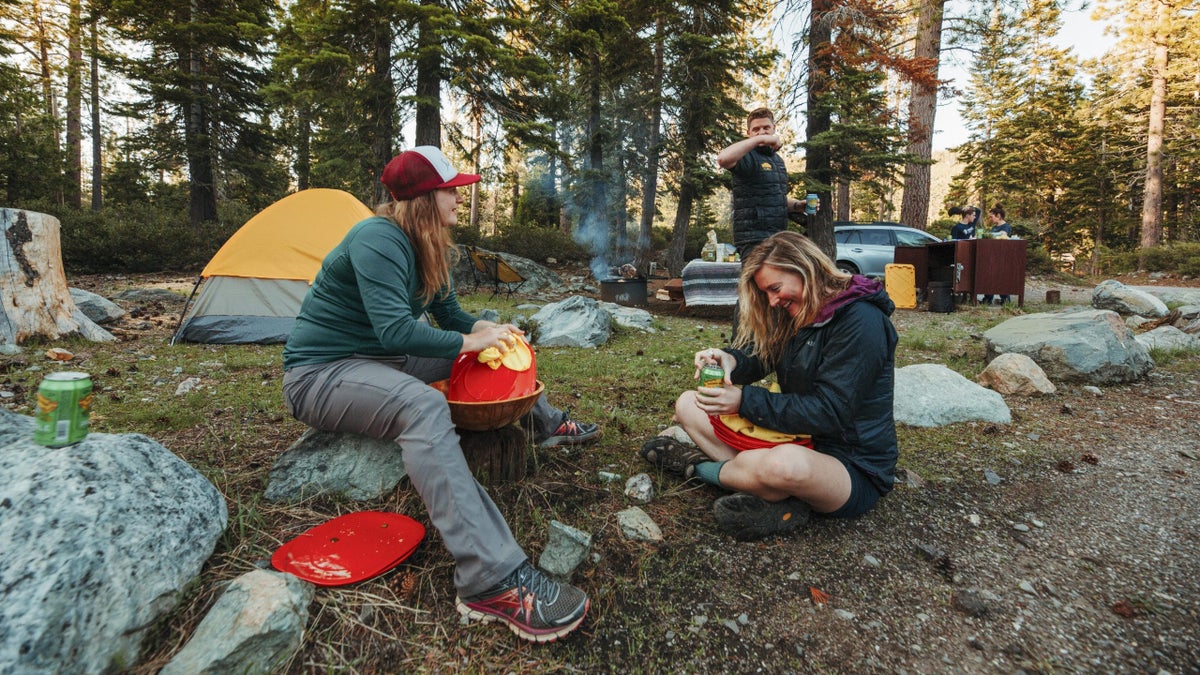No products in the cart.
Outdoor Adventure
The Laid-Back Adventurer’s Guide to Outdoor Skills
Spending time in the great outdoors can be intimidating (do you even whitewater SUP?). But it doesn’t have to be. In fact, some of the most foundational outdoor skills are easy to learn and, more important, fun to practice. So crack open a Sierra Nevada Pale Ale—the unofficial official beer of camping—and learn something new.
Tie a Bowline Knot
There are hundreds of useful knots an outdoorsperson should know (no pressure) but perhaps none is as versatile as the bowline: use it to string up a bear bag, to tie your canoe to a tree, or any other time you need a loop that won’t slip under tension and can be easily untied. Start by looping your rope around (or through) whatever you’re connecting it to (e.g. a trailer hitch or cooler handle). On the standing side of the rope, create a small loop that faces the loose end of the rope. Feed the end of the rope up through the loop, around the standing end of the rope, and then back through the loop. Lost? This animation should help.
Identify Constellations
While simply gazing up at a starry sky is rewarding in its own right, being able to recognize actual constellations adds a surprisingly satisfying element to the experience. First, understand that the Big Dipper isn’t a constellation. Sorry. But it is a good place to start: the two stars that mark the outer edge of the ladle point toward Polaris, the North Star. And the handle is the tail of an actual constellation called Ursa Major, or Big Bear. The big spoon is Ursa Major’s back and belly. Ursa Major’s head extends from the top of the ladle and the legs pop off the bottom of the ladle. Does it take a good imagination to see the outline of a bear in the stars? Yeah. But it’s there, we promise. Check out this easy guide to constellations to learn more.
Use a Map and Compass
Being able to orient a map using a compass is the basis of navigation, but it’s also a fun challenge and it frees you from the shackles of modern technology. First, adjust your compass’s declination (the difference between magnetic north and true north), which should be listed on your topo map. Then place your compass on the right edge of the map. Rotate your bezel so N (north) is lined up with the “direction of travel” arrow at the top of the compass (because all maps are designed with north at the top of the map). Hold the map and compass together as one piece, flat in front of you, and rotate your body until the red orienting needle is lined up with the fixed red orienting arrow. This orients your map and will enable you to identify landmarks (creek! steep slope! high peak!), find those same features on the map, and figure out where you are and which direction you need to walk.
Bake a Cake in a Dutch Oven
S’mores are great, but a legit chocolate cake baked on the campfire? That’s next level. And you can do it with a Dutch oven. Start by getting a fire going. Standard charcoal is easier to use because you can regulate the heat better, but you can use wood coals too. While the fire is getting hot, assemble a cake mix in a bowl and oil a cast-iron Dutch oven liberally. Place parchment paper on the bottom of the oven and oil that too. Pour in the batter, cover with the Dutch oven’s lid, set it on several hot coals, and place twice as many coals on top of the lid. Sit back with a cold Pale Ale while you wait.
Identify Birds
So you see a bird. It’s pretty. Want to know what kind it is? First, you need a field guide to birds in your area. Next, get a good look at the bird, making a mental note of its size, shape, and colors. What’s the most noticeable thing about the bird? Pay special attention to its head, looking for colors and patterns. Then move your gaze backward, examining its body, legs, and wings. Now that you have a mental picture of the bird, go to your field guide and start trying to match the characteristics you noticed, keeping in mind its size, shape, and distinctive characteristics. Your location is also a big clue because the matching bird in your book has to have a natural range that includes your backyard or campsite. Like solving bird mysteries? The Audubon Society goes into greater depth.
Open a Beer with a Mountain Bike
OK, this isn’t exactly an essential outdoor skill, but it’s certainly a crowd pleaser. Here’s the situation: you remembered to pack some post-ride Pale Ales but not the opener. Don’t fret—clipless bike pedals were basically engineered for this task. Hook the bottle cap in as if it were your riding shoe’s cleat, rotate the pedal, and, voilà, your beer is open.
Family owned, operated, and argued over since 1980, Sierra Nevada Brewing Co. is one of America’s premier craft breweries. Our classic Pale Ale introduced a generation to the glory of hops, and we keep pushing boundaries with innovations in the brewhouse and advances in sustainability.
Source link

